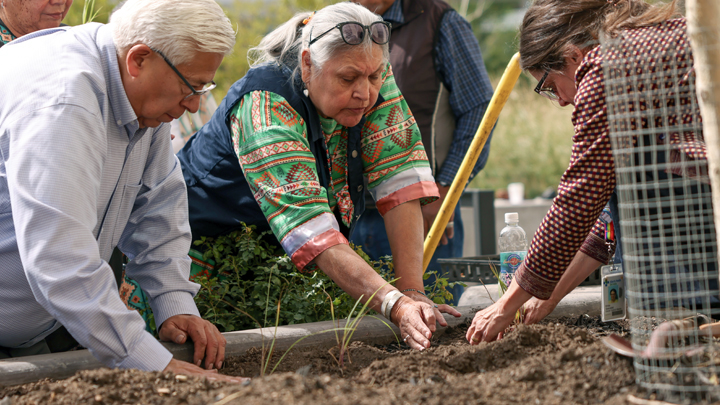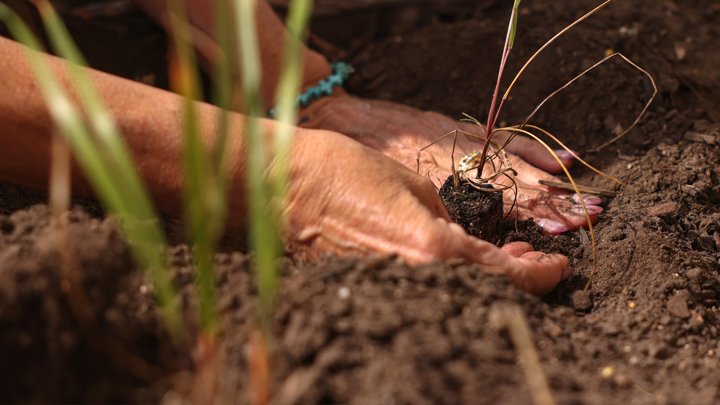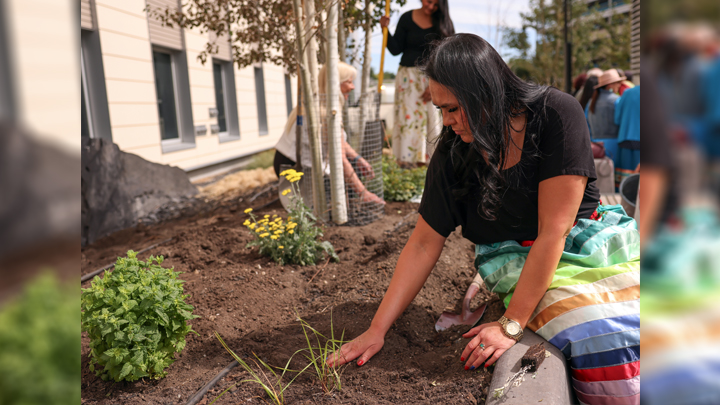
September 20, 2024

Members of Indigenous communities take time to plant sage, tobacco and sweetgrass at the new Arthur J.E. Child Comprehensive Cancer Centre in Calgary. Photo by Leah Hennel.

“The Indigenous people have always been connected to mother earth,” says George W. Pambrun, a Metis cancer survivor. Photo by Leah Hennel.

By incorporating Indigenous traditions — including the planting of sage, tobacco and sweetgrass — as well as other cultural practices into the cancer centre, the Arthur Child is not only providing physical care, but offering a spiritual and emotional sanctuary. Photo by Leah Hennel.
Story by Jennifer Green | Photos by Leah Hennel
CALGARY — The new Arthur J.E. Child Comprehensive Cancer Centre (Arthur Child) is a beacon of hope for many, offering state-of-the-art medical care in a supportive environment. However, for Indigenous patients, the centre offers something more — a connection to their cultural heritage.
“My brother passed away from cancer and he was in the Tom Baker, and while he was in there, they took very good care of him. When we wanted to do ceremony, they accommodated us,” says Frances Crowchild Jensen of the Tsuut’ina Nation recalls. “And so coming here (to the Arthur Child) and seeing everything that they have for First Nations people— it touches me.
"Ceremony is very important. We are raised from when we were small to pray. For Indigenous peoples, traditional practices like smudging and offering tobacco hold deep spiritual significance. These rituals provide comfort, strength and a sense of connection to the natural world.”
George W. Pambrun, a Metis cancer survivor, echoes the importance of cultural inclusion: “The indigenous people have always been connected to mother earth … plants, animals, respect.”
The presence of Indigenous plants such as sweetgrass, tobacco, and sage at the cancer centre serves as a tangible reminder of this connection. Larry Waterchief, director of Elder Services for the Siksika Nation, praises the healing properties of these plants: “Some of those plants are used for healing. That’s what our people use. People still go out and harvest the plants to make traditional medicine to help in the treatment of cancer.”
Pambrun, a Metis elder, expressed gratitude for the centre's efforts to create a culturally-inclusive environment. “It means so much to me that the hospital recognizes the importance of our traditions. It feels like I'm not just a patient, but a person who is valued and respected.”
By incorporating Indigenous traditions and practices into the cancer centre, the facility is not only providing physical care, but also offering a spiritual and emotional sanctuary.
As Frances Crowchild Jensen adds: “Seeing the plants and the medicines outside — it’s like showing us respect — and maybe somewhere there’s a belief that our way works also.
“We can work together with our medicine and the western medicine, because Creator put us all here to live together. If we can utilize each other in a good way, why not?”
The Arthur Child is set to open for patients at the end of October. The Indigenous communities have access to an Indigenous room specifically designed for smudging or prayer, the outdoor gardens and a sacred space.